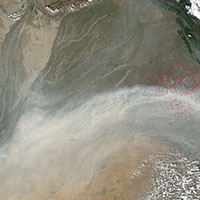
On the Indian subcontinent, the widespread burning of firewood, coal, agricultural waste and biomass for energy has dispersed a critical mass of black carbon particulates into the atmosphere. These manmade aerosols not only pollute the air but also form an “atmospheric brown cloud” that’s disrupting the local climate. A case in point is the South Asian summer monsoon, a complex system of winds that typically bring rain from the tropical Indian Ocean to most of the region, especially in the southwest and northeast. The aerosols, which block solar radiation and cool the ground before they get swept away by rain, have altered the monsoon considerably.
In previous investigations of the local climate impact of aerosols present in the atmosphere during the onset stage of the summer monsoon, MIT researchers found that rainfall increased in the month (June) prior to the monsoon, and decreased during the monsoon season (July and August). Now, in a study published in Journal of Climate, they have determined how aerosols emitted both before and during the monsoon are changing precipitation patterns.
“Aerosols can influence the supply of moisture, and a small perturbation can play a big role,” says study coauthor Chien Wang, a senior research scientist at MIT’s Center for Global Change Science and the Department of Earth, Atmospheric, and Planetary Sciences. “Pre-monsoonal aerosols push rainfall to the northwest, drying out central India. Aerosols emitted during the monsoon season send the moisture supply in a different direction and dry out most of the subcontinent.”
The most dramatic consequences are enhanced flooding in the pre-monsoon season in the normally dry northwest regions of India and Pakistan, and reduced agricultural output in central India, which now gets far less rainfall than usual during the monsoon season.
The study produced its findings by running a global climate model to simulate the impacts of aerosols emitted before, during and throughout the monsoon season in all but the northeast region of India, which is not well-represented in the model. The effects of pre-monsoonal aerosols—increased rainfall in the northwest, decreased rainfall elsewhere, particularly in central India—persist during the monsoon, further reducing soil moisture in central India. Aerosols emitted during the monsoon lower rainfall totals not only in central India but across the country. When aerosol emissions are simulated throughout both periods, impacts during the monsoonal period are similar to those resulting from monsoonal aerosols only.
The research was funded by the Singapore National Research Foundation through the Singapore-MIT Alliance for Research and Technology Center for Environmental Sensing and Modeling, and grants from the National Science Foundation, Department of Energy and Environmental Protection Agency.
PHOTO: An ''atmospheric brown cloud'' of manmade aerosols produced by agricultural (marked in red) and other fires may reduce monsoon-related rainfall and crop yields in central India. (NASA image by Jesse Allen, Earth Observatory)

